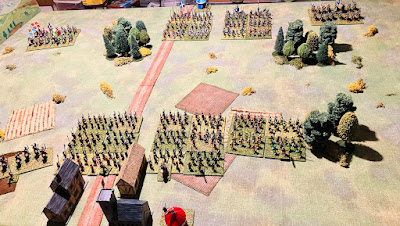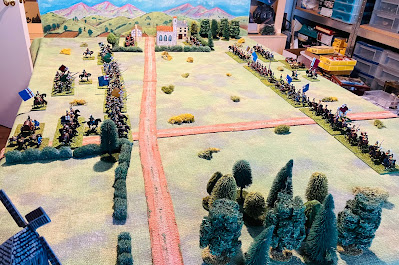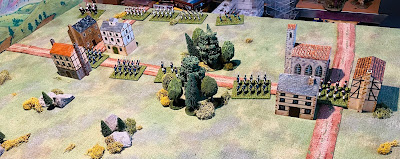I recently purchase the Arrowstorm medieval rules written by Daniel Mersey, better known for his work on the Lion Rampant rules. These rules are available at a reasonable price ($9.47) on Wargame Vault under the publisher "Daniel’s Game Emporium". You just have to download and print. The design notes which are many, tabletop setup, rules, army lists, and quick reference take up 34 pages.
What caught my interest in these rules was the activation system which uses a tactics chart, and they are intended for a fast play game. Interestingly, the rules themselves were based upon some rules used for recreating the Battle of Evesham, 1265, and published previously in Military Wargames magazine (issue 387). These are also included in the 34 pages.
 |
| The tabletop prepared and the armies deployed. |
 |
| The rules downloaded and printed. There was only one colour page, the rest being black and white and not heavy on the use of ink. 34 Pages in all. |
The rules use an offset grid, with each square needing to accommodate up to 6 units (3 friendly and 3 enemy units). Initially, this posed a challenge for me as my units were based on two 4-inch by 3-inch stands and I play on a 6-foot by 4-foot tabletop. After experimenting with various approaches and square sizes, including halving my units to a single stand within the grid, I ultimately decided to adopt a free movement system. This meant that units needed to operate in a cohesive block with other units, so 3 units operating together were placed one behind each other. On the tabletop this gave the impression of the armies being organised into battles, provided a medieval look to the game.
 |
| The game uses an offset square grid. But I was able to adjust the rules to use free movement as my unit basing was too large to really accommodate up to 6 units in a square. |
 |
| The deployed armies into blocks (or battles). Most of the blocks have 2 or 3 units. |
The main reason behind my purchase of this Arrowstorm was its activation system, which revolves around a tactics chart. This chart comprises 12 tactical options, such as movement, battling, shooting, etc., with players taking turns to select their preferred tactic. Additionally, the inclusion of a couple of special tactics unique to each army list adds some characteristics to the armies; for instance, "arrowstorm" is a special tactic for the English Hundred Years War armies giving a bowmen unit extra benefits when shooting.
Players are limited to choosing a maximum of 4 tactics in most cases. I found the whole tactical chart mechanism most enjoyable and intriguing, for example:
- Selecting the “seize the initiative” tactic, allowing you to activate a unit or group of units first, but at the expense of an activation.
- Choose a tactic that might not directly benefit your army but by selecting it will hinder your opponent's choices.
The other feature of note are that activations apply to the square containing the units, not the individual unit, although you can just activate one unit if you choose to do so. For my game the activation is applied to groups of units. Units or groups of units can be activated more than once during a game turn, so units may end up shoot or moving twice.
 |
| Tactics being selected on the tactical chart. Generally 4 tactical are selected, but this can be reduced or increased in certain situations. |
A Battle report…
Arrowstorm provides rules and army lists with a unit point system for a player to select their army and setup the tabletop. For this test game the following order of battle was used.
French:
- 2 x Mounted Knights
- 2 x Mounted Sergeants
- 3 x Crossbows
- 1 x Foot Knights
- 2 x Spears
English:
- 1 x Mounted Sergeants
- 3 x Longbows
- 3 x Foot Knights
- 2 x Spears
The French were formed into 4 battles with cavalry positioned on each flank and the English into 3 main battles with a single units of mounted sergeants on their left flank.
 |
| The initial deployment. The English army is deployed in front of a town. |
Turn 1 - The French seize the initiative, pushing forward their mounted knights along with one of their central battles containing two crossbow units. Volleys of arrows are exchanged, resulting in a hits allocated across the units within each battle. (Note - the English seized the initiative for the next game turn.)
 |
| Turn 1 - both sides advance. |
Turn 2 - After seizing the initiative, the English unleash an arrowstorm upon the French mounted knights, inflicting casualties, although the knights persist in their charge. Nevertheless, significantly weakened, they are eventually eliminated at some cost by the English battle comprising archers, spearmen, and foot knights. On the opposite flank, the French commander leads his troops forward, resulting in a swift clash with the opposing English battle, with casualties being sustained on both sides.
 |
| Turn 2 - The French mounted knights are eliminated while two battles engage in melee. |
Turn 3 - The French commander leading his troops successfully eliminated the opposing English battle in melee, all the while both armies continuously showering their opposition with arrows. The English make no manoeuvres, opting instead to focus on rallying their troops.
 |
| Turn 3 - The French right battle eliminates an English battle. |
Turn 4 - The English army was happy to persist in shooting with their remaining bowmen, while the French, somewhat belatedly, advanced their mounted sergeants and engage in some rallying efforts.
 |
| Turn 4 - The French try an reorganise and bring up their mounted sergeants while under constant shooting by the English bowmen. |
Turn 5 - Observing the battle's momentum was favouring the English and their defensive strategy, the French commander initiates an assault with his significantly diminished battle. However, the opposing English battle, under the leadership of their commander, easily repels the impulsive attack. Witnessing their commander's downfall, the French forces withdraw, conceding victory to the English.
 |
| Turn 5 - A final assault by the French is not successful and the English triumph this day. |
Thoughts on the first game…
I found the tactical system to be most enjoyable as it introduces a planning aspect to the start of each game turn.
Following a single play through, referring to the rules became minimal, aside from checking on the special tactics.
The use of free movement and unit groups appeared to work. One restriction I implemented was that when a group of units is in contact with another group (similar to opposing units occupying the same square in the rules), you can only add to your group if it comprises fewer than 3 units, and flanking or rear attacks are not permitted. Similar to squares, this requires careful consideration of the unit composition within your groups (battles).
The combat mechanics, both shooting and melee, are straightforward and abstracted (as stated in the game’s design notes). However, they tend to result in rather bloody and decisive encounters with few prolonged engagements. This can give a significant advantage to units striking first. Although, if so desired, the rules could be easily be tweaked to provide less decisive outcomes.
The tactics chart, particularly its restriction of activations, compels players to maintain their units grouped into cohesive battles. Dividing units too thinly can result in a significant portion of the army remaining inactive in the game, and if attacked they would put up little resistance.
I found these to be a very interesting set of rules, particularly the tactic chart rule mechanism, all in all very clever. The set of rules is part of the “You Command” series of rule by Daniel’s Game Emporium which offers other period Dark Ages and WW2 using similar tactical chart approaches.
It is very tempting to get some 6mm or 10mm medieval figures and create a small footprint game for the dining room table. Says me reaching for the credit card.







































